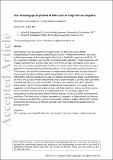Assessing spatial patterns of soil erosion in a high-latitude rangeland
Abstract
High‐latitude areas are experiencing rapid change: we therefore need a better understanding of the processes controlling soil erosion in these environments. We used a spatiotemporal approach to investigate soil erosion in Svalbarðstunga, Iceland (66°N, 15°W), a degraded rangeland. We used three complementary datasets: (a) high‐resolution unmanned‐aerial vehicle imagery collected from 12 sites (total area ~0.75 km2); (b) historical imagery of the same sites; and (c) a simple, spatially‐explicit cellular automata model. Sites were located along a gradient of increasing altitude and distance from the sea, and varied in erosion severity (5–47% eroded). We found that there was no simple relationship between location along the environmental gradient and the spatial characteristics of erosion. Patch‐size frequency distributions lacked a characteristic scale of variation, but followed a power‐law distribution on five of the 12 sites. Present total eroded area is poorly related to current, site‐scale levels of environmental stress, but the number of small erosion patches did reflect site‐level stress. Small (<25 m2) erosion patches clustered near large patches. The model results suggested that the large‐scale patterns observed likely arise from strong, local interactions, which mean that erosion spreads from degraded areas. Our findings suggest that contemporary erosion patterns reflect historical stresses, as well as current environmental conditions. The importance of abiotic processes to the growth of large erosion patches and their relative insensitivity to current environmental conditions makes it likely that the total eroded area will continue to increase, despite a warming climate and reducing levels of grazing pressure.
Citation
Streeter , R T & Cutler , N 2020 , ' Assessing spatial patterns of soil erosion in a high-latitude rangeland ' , Land Degradation & Development , vol. Early View . https://doi.org/10.1002/ldr.3585
Publication
Land Degradation & Development
Status
Peer reviewed
DOI
10.1002/ldr.3585ISSN
1085-3278Type
Journal article
Description
Thanks to NSF grant 1202692 for support to RS. NC was supported by a grant from Churchill College, Cambridge. Thanks to Jim Woollet for advice and support. DEMs provided by the Polar Geospatial Center under NSF-OPP awards 1043681, 1559691, and 1542736.Collections
Items in the St Andrews Research Repository are protected by copyright, with all rights reserved, unless otherwise indicated.

